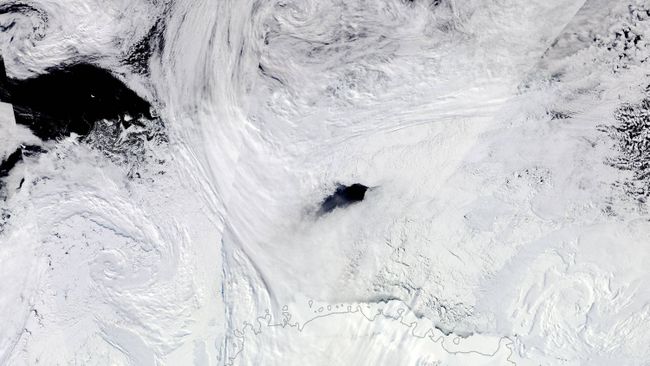In the 2016-17 period, a hole the size of Switzerland appeared in Antarctica’s sea ice. The reason behind this phenomenon has now been uncovered.
After many years, researchers have been able to solve the mystery that surrounded the ‘Maud Rise polynya’.

During the austral winter, the sea ice immediately surrounding Antarctica also undergoes a marked increase, in effect growing to twice its size. However, in the winters of 2016 and 2017 there was a phenomenon – there was a large hole, or as the scientists call it, a polynya, in the middle of the sea ice, which size equals the size of Switzerland. Finally, they have found out the causes for its formation through conducting several studies.
The polynya was called Maud Rise after the seamount that is located below it in the Weddell Sea. Another research shows that how wind, ocean current, and the seafloor helped in shaping the environment to create polynya. These conditions ensured the right salinity for the sea which was essential for the melting of the sea ice.
In fact, Maud Rise polynya has existed before the year 2016. It was first observed by earth sensing satellites in the 1970s, especially during the winter periods of 1974-1976. Researchers first expected it to re-emerge each winter, but it only does so occasionally for several months at a time.
The study is led by Aditya Narayanan, a postdoctoral research fellow at the University of Southampton in England, who pointed out the relevance of the polynya’s occurrence in 2017. He claimed that this was the first time since the 1970s that a polynya of this size and duration had been recorded in the Weddell Sea.
The circular ocean current in the Weddell Sea was exceptionally strong during 2016 and 2017 and therefore played a role in the occurrence. This increased the current round Maud Rise, and upwelling brought water that was warmer and saltier to the surface.
A physical oceanographer from the University of Gothenburg in Sweden, part of the study group, Fabien Roquet, described how the upwelling is significant in the context of the melting of sea-ice. Nevertheless, as the sea ice melts, it results in the freshening of the upper ocean watery surface, which in turn should ideally stop the mixing. This raises the next issue of sustainability of the polynya, which represents a large area of open water surrounded by the ice cover. Roquet has noted that there has to be other sources of salt input apart from the sea.
With regards this, the team relied on satellite, autonomous float and migration patterns from tagged marine life. That is why Maud Rise disturb flow of warm water and signaled turbulent eddies which bring more salt to the area. This salt was then taken through the Ekman transport which is a movement that occurs right above the ocean currents and water influenced by the wind.
Sarah Gille of the University of California, San Diego and also one of the team members of the conducted study pointed out that the effect of polynyas was to perpetually change the water. Despite that, their impacts can be long-term, spanning several years after the formation of the landscape. These polynyas can change the flow of water and determine how the currents move warm currents to the continent. Besides, the waters become dense in these areas, and can be transported in the Global Ocean.
The results of this work were published in Science Advances earlier this year and can increase the understanding of the exciting processes within polynyas and the role they play in the behavior of the Earth’s oceans.
Do not forget to share your opinion with us to provide you with the best posts !



0 Comments